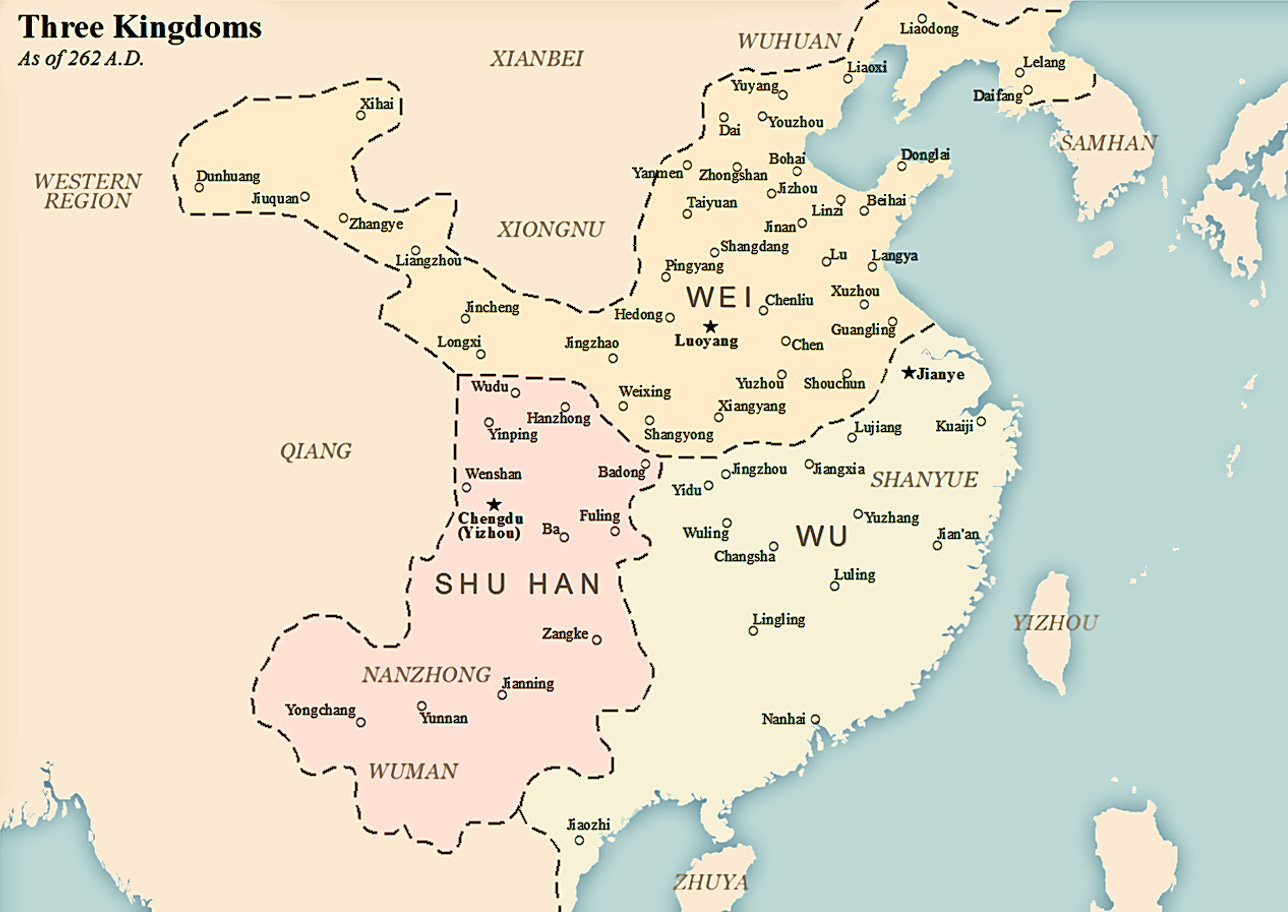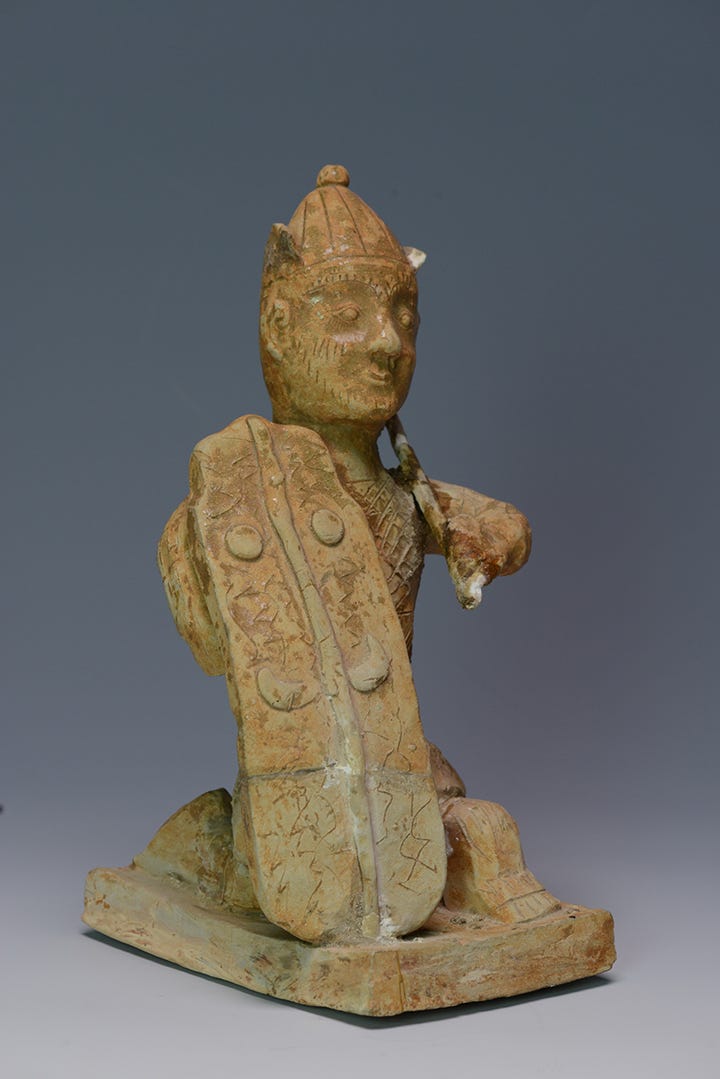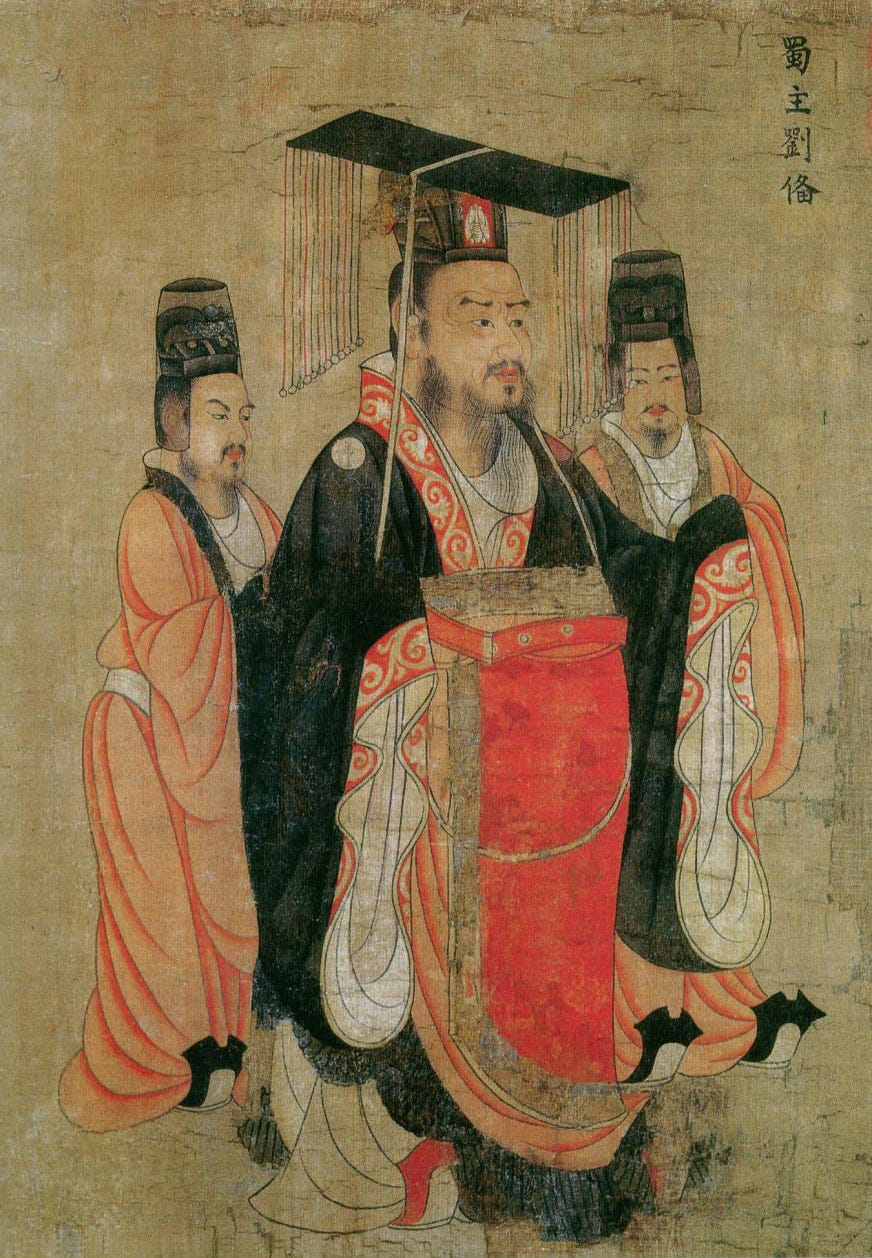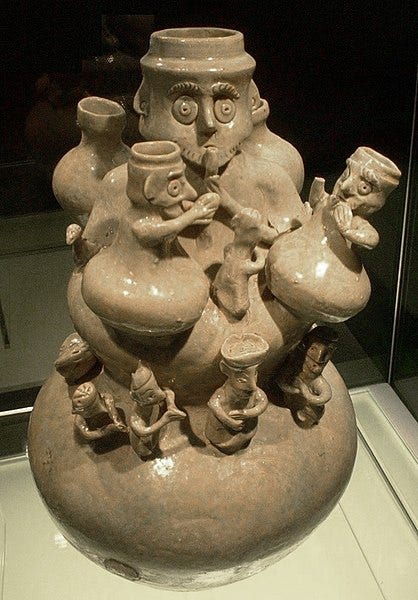A Thermodynamic Romance of Three Kingdoms
3rd Century lessons into the "thermodynamics" of a "world" split into three competing sides or poles.
Bird's Eye View
This is essay 1 of 4 essays for 1729 Writers Cohort #2. 1729 Writers is a group that writes to build on ideas related to Balaji Srinivasan’s new book The Network State, which can be ordered here. This post is purely academic in nature, and it does not constitute any formal political, scientific, legal, financial, social, religious, or ethical advocacy. For earlier posts and musings, please visit whatifwhatif.substack.com.
In a nutshell, this essay will make an attempt to connect lessons in history with natural scientific laws. Specifically, it deep dives into the phenomena of competition between three political poles using a 3rd Century A.D. historical case study — and in the end it synthesizes tie-ins with the three Laws of Thermodynamics. Let's dig in!
Introduction
Through a series of no-punches-withheld discussions, Balaji Srinivasan's The Network State explores how we have arrived at the world of 2022, where we may be headed next, and what we can do to create new futures characterized by opening of new non-zero sum frontiers in the form of network states. In short, in a world headlined by a possible Second American Civil War and a possible Second Cold War, network states — through what Balaji calls “cloud first, land last” — could give hundreds of millions an alternative paradigm out of seeming impasse and zero-sum competitions.
In his book, Balaji contends that the world of 2022 is becoming divided into three competing poles, which can, to an extent, be paraphrased in broad terms as establishment US, establishment PRC, and crypto maximalists. Another related broader view could be a tri-polar competition between G7, BRICs, and people of the Internet. Those interested in the details of Balaji's proposition of tri-poles can find further explanations in his book.
An understanding of history is important to understanding the present and future — after all, human genetics don't change dramatically over centuries. This essay will be an attempt and exercise into history to explore a past instance of tri-polar competition and objectively - as much as possible - draw some lessons from it. There have been countless literature, films, games (and more recently, this Total War rendition), mangas, and other audiovisual products based on the Three Kingdoms era (circa 220 - 280 A.D.), so it is an era that many people, including many Westerners, are at least somewhat familiar with. The Three Kingdoms era (which divided into the kingdoms of Wei, Shu-Han, and Wu) is often overly used by scholars and commentators to make historical comparisons (sometimes oversimplifying a complex N-situation into a 3-situation), so I have in the past avoided making direct references to it. That said, many are already at least basically familiar with Three Kingdoms, and one could argue aspects of 3rd Century A.D. could repeat this century, so it could be interesting to delve into such a 3rd Century A.D. exercise.
Three Kingdoms Map. (Source: SY, under the Creative Commons Attribution-ShareAlike 4.0 International License)
Again, this essay assumes a basic understanding of the Three Kingdoms era, but for those interested in learning more about the era, select wiki links are embedded (see underlined terms and names). For the bulk of the essay, we will take a stroll down history lane and explore two core lessons from each of the three sides in this tri-polar era. At the end of the essay, after extrapolating core lessons from such a historical period with tri-polar split or equilibrium, we will then conduct a further exercise, by trying to map onto the Laws of Thermodynamics. Sometimes, insights into history and principles of nature could align.
Kingdom of Wei
The Importance of Scale
At the end of the day, scale matters. It's intuitive that the side with the biggest scale stands with the highest chance to simply outlast the sides. Let's look at the relative scales of the Three Kingdoms: According to official records (may require Google translator), Kingdom of Wei, which ruled the central plains heartland and the fully developed north, had a productive agrarian population of around 4.39 million, outstripping the Kingdom of Wu's 2.52 million and the Kingdom of Shu-Han's 1.04 million. Now, there had been speculations that the actual populations were higher than officially reported numbers, due in large part to many poor families and farmers becoming semi-serfs hidden in the estates owned by large clans of the time. But the scale differences between the three kingdoms would still be relatively similar.
Someone nerded it out McKinsey-style and did an estimate of the relative Three Kingdoms GDPs in present-day RMB (divide by approximately 6.7 for USD figures), based on a summation of production from agriculture, iron-making, textile, and salt trade (arguably the four biggest GDP pillars back then). Without diving into the sausage making (those interested can find the analysis here, but Google translate may be necessary), here are is the approximate GDP comparison in today's terms: 7.1 billion RMB (1.07 billion USD) for Kingdom of Wei, 4.1 billion RMB (612 million USD) for Kingdom of Wu, and 1.7 billion RMB (253 million USD) for Kingdom of Shu-Han. Again, the Kingdom of Wei claimed dominance in scale.
Simply put, the Kingdom of Wei (and its successor the Jin dynasty) was able to harvest the most grain, collected the most taxes, draw the most talent, raise the largest armies, and replenish from causalities with the most ease. As armies of foot-soldiers eventually marched into Chengdu (capital of Shu-Han) in 263 A.D. and hundreds of ships eventually sailed to Jiankang (capital of Wu) in 280 A.D., scale prevailed after all.
So, here is the first 3rd Century lesson: All else being equal, the pole or side that accumulates the largest scale would likely prevail. But…given the vast differences in scale, one would wonder why Kingdom of Wei didn't prevail earlier? We will tackle that next.
The Pitfalls of Multi-Front War
One reason that the Kingdom of Wei (and by extension, its successor the Jin dynasty) did not prevail earlier was due to it being identified as the primary “antagonist” by the two other poles. An understanding of their respective size disparities also allowed the kingdoms of Shu-Han and Wu to set aside their differences and form alliance against Kingdom of Wei for much of the Three Kingdoms era.
Aside from incursions by Shu-Han armies almost every other year in the name of restoring the Han dynasty, the Kingdom of Wei suffered from both "civil wars” or purges, as well as from external wars on all directions. Cao Pi, the first Wei emperor, had deposed the Han dynasty that ruled for over four centuries previously. Hence, by becoming the de-facto successor of “the establishment,” it also became the de-facto common target for every other kingdom, warlord, or political interest within and around its borders. Internally, the Sima clan feuded with Wei's ruling Cao clan to eventually replace it and found the Jin dynasty. Externally, besides defending against Shu-Han frequently and Wu on occasions, the Kingdom of Wei had to deal with the Gongsun clan of the northeast, Goguryo, and various tribes to the northern and western borders.
Kingdom of Wei Shieldbearer. (Source: Under Creative Commons Public Domain)
Relatively speaking, the Kingdom of Wei was, to borrow a Balaji concept, one of the biggest multi-nation states of its era (those interested in Balaji's nation state definitions can read here). Clans from various northern and western nations such as Hsingnu (aka the Huns, according to some historians), Xianbei, and Qiang also immigrated into much of Wei's territory (Shu-Han and Wu states also governed over various southern nation populations, but at much fewer numbers compared to Wei). In summary, positioned as an usurper (of the Han dynasty) devoid of moral right, saddled with multi-ethnic nations within its borders, and fighting multi-front conflicts, the Kingdom of Wei could not quickly covert its scale advantages to end game victory (though arguably it eventually did many decades afterwards through its successor the Jin dynasty).
So, here is a second 3rd Century lesson: Home front divisions and multi-front juggling could rebalance the competitive scale (at least for a time). So…what other lessons can we observe from the other two poles (kingdoms)? Let's go there next.
Kingdom of Shu-Han
The Importance of Higher Moral Purpose
In a sense, compared to the other two poles, the Kingdom of Shu-Han was a startup state with a strong singular moral purpose, and its founder, Liu Bei, had a life that mirrored many less-than-lucky startup founders. Despite his claims of being descended from Han dynasty royalty, Liu Bei actually came from an impoverished family and spent his youth making straw shoes to support his mother. He did not have elders in high court places like Cao Cao, the founder of Wei, nor did he inherit a kingdom like Sun Quan, the first emperor of Wu. Known to be ambitious, charismatic, and kind (a rare quality combination in the 3rd Century), Liu Bei started from a humble position, bouncing between warlords and taking refuge after multiple defeats, and did not possess a stable base of operations until he was nearly fifty years old.
Yet, despite shortcomings in wealth, power, and status, Liu Bei possessed an aura that attracted both the gentry and the masses. His humble upbringing in the peasantry gave him a willingness to give the highest respect to almost anyone that he came across, as well as a tendency to empathize with the ordinary folk (Liu Bei was known as one of the few warlords who did not massacre and sack resisting cities, which was a common practice back then). Despite repeated defeats, Liu Bei had a loyal, die-hard following, including the famed Guan Yu, Zhang Fei, Zhao Yun, and Zhuge Liang, which grew even bigger over time. And despite being persecuted by his enemies, Liu Bei attracted hundreds of thousands of common folk to his side (see Battle of Changban).
Liu Bei, the Founder of Shu-Han. (Source: Thirteen Emperors Scroll, 7th Century, under Public Domain)
Besides ambition, charisma, and kindness, what drew the gentry and common folk alike to Liu Bei was also his embodiment of a higher moral purpose — namely the restoration of the four-hundred-year-old Han dynasty from war, chaos, and usurpation. Starting with nothing, Liu Bei founded the Kingdom of Shu-Han after experiencing decades of trials and tribulations, and he injected a moral story into the soul of his startup state: Liu Bei was the last survivor of a secret group who was handed the task of eliminating usurpers and restoring the Han dynasty lineage by Emperor Xian, last official emperor of the dynasty. Hence, thousands of believers in the Han dynasty travelled from afar to follow Liu Bei and join the Kingdom of Shu-Han.
A culture with higher moral purpose survived Liu Bei and became deeply embedded in Shu-Han's ethos. For decades after Liu Bei's death, the Kingdom of Shu-Han stood highly united — despite it being the weakest of the three poles in terms of wealth, population, and territory. Unlike the kingdoms of Wei and Wu, Shu-Han did not experience any significant usurpation, court power struggles, internal divisions, or major instances of corruption. Countless generals of Shu-Han fought to their death defending the Han dynasty's restoration; many ministers of Shu-Han died nearly penniless, their entire lives dedicated to the service of Shu-Han's One Commandment (to borrow a term from Balaji). To an extent, Shu-Han's followers were the 3rd Century version of Bitcoiners who HODLed through trials and tribulations.
Shu-Han's moral proposition was so strong that future dynasties and generations more than one thousand years later still revered it. Temples and shrines were built in honor of Liu Bei, Guan Yu, Zhang Fei, Zhao Yun, and Zhuge Liang. Even today, novels, plays, films, and even video games about the Three Kingdoms would headline the characters of Shu-Han as opposed to those of Wei and Wu.
Hence, here is another important lesson from the 3rd Century A.D that mirrors Balaji's ideas for startup states: A higher moral issue or purpose will sustain a startup state and strengthen its pole position. But…given Shu-Han's strength and solidarity, what had prevented it from becoming more successful? We cover that next.
The Pitfalls of Predictability
The Kingdom of Shu-Han was determined and driven by a higher moral purpose (to eliminate usurpers and restore the “rightful” Han dynasty), but it was equally stubborn and predictable in deployments, strategy, and tactics, which made it easier for the other side to defend against it. From 228 A.D. to 234 A.D., Chancellor Zhuge Liang launched five offensive expedition campaigns against Wei, all in the same direction and all fairly predictable by the opponent's defense, and all five campaigns ended in retreat (and in the fifth campaign, Zhuge Liang's death). Grand General Jiang Wei launched eleven subsequent expedition campaigns against Kingdom of Wei from 240 A.D. to 262 A.D., all attacking or approaching areas near the western district of Longxi, but none of them were successful or yielded any significant gain.
Meanwhile, for nearly four decades, the Kingdom of Wei rarely ran offensive campaigns agains Shu-Han, but when it finally launched a major offensive in 263 A.D., it took a less-than-predictable route to Chengdu, Shu-Han's capital, and succeeded in conquest. Shu-Han's record: 0-16. Wei's record: 1-0.
So, there is another 3rd Century lesson: Predictability limits potential. Next, we will take a look at Kingdom of Wu, the third of the three poles.
Kingdom of Wu
The Importance of Being "Third Wheel”
When people recall the Three Kingdoms, they first think of Wei and Shu-Han, while Wu comes a distant third. This was even true contemporarily at the time. Most literature, films, and even video games would also first highlight the heroes of Shu-Han attempting to restore Han dynasty versus the establishment of Cao Cao and the subsequent Wei. Wu, on the other hand, almost feels like an afterthought, like a “third wheel.”
Yet, being the “Third Wheel” had tangible benefits. Diplomatically, both Wei and Shu-Han, who presented irreconcilable differences in values and moral positions, attempted to woo Wu (no pun intended!) to their side. Wu could act as a balancing weight to work with one side against the other side that weighed the most. Militarily, Wei could sit and watch as Shu-Han and Wei engaged in almost annual wars, while picking strategic times to enter (if at all). Economically, the relative peace allowed Wu to develop the Yangtze delta, pacify Shanyue groups in its southeastern mountainside, and even develop trade with regions as far away as what is modern day Vietnam, Cambodia, and India. By oftentimes staying under the radar, the Kingdom of Wu survived the longest amongst the Three Kingdoms (compared to Shu-Han, which was conquered in 263 A.D. and Wei, those throne was usurped in 265 A.D.), outlasting the other two by more than a decade (until its eventual, almost inevitable conquest by an ascending Jin dynasty in 280 A.D.).
Kingdom of Wu Vase. (Source: Under Creative Commons Public Domain)
Thus, we have another 3rd Century lesson: In a competition between three sides or poles, being "third wheel” may help preserve strength and bide time. But being the “third wheel” also has drawbacks, and we will cover them in the next section.
The Pitfalls of Being "Third Wheel”
While being “third wheel” allowed the Kingdom of Wu time, energy, and relative peace and to develop internally, it also constrained Wu's external ambitions. For much of its existence, the ruling Sun family of Wu had to forge an alliance with the large local clans of the Yangtze delta, which provided much wealth and manpower to the regime. Most of these clans were content to preserve the status quo locally as opposed to engage in extended campaigns elsewhere. Wu did not embed a higher moral purpose like Shu-Han did (after all, restoring the Han dynasty would threaten its own existence), so it found not find enough moral justification to expand further north beyond a key defensive strongholds. Wu also did not possess Wei's scale to withstand extended conflict, and thus it was less proactive launching offensive campaigns — in fact, most of the battles Wu engaged in were defensive.
Lacking moral authority and establishment scale, the Kingdom of Wu spent all of its existence simply keeping a status quo in the southeast. So here is one more lesson from the 3rd Century: In a competition between three sides or poles, being "third wheel” for too long could relegate one to irrelevance.
Conclusion and Thermodynamics Connections
Finally, at the end of our exercise, let's summarize the lessons of 3rd Century A.D. from earlier:
Scale matters — a lot! But having too many fronts could slow one down.
Embedding a higher moral purpose is key, but being too one-dimensional makes one predicable and thus limited.
Being a “third wheel” could give flexibility for a time, but after a long time it could mean irrelevance.
These points or lessons could also, to an extent, map to the three Laws of Thermodynamics, which define properties of equilibrium in physically closed systems. In a relative historically and geopolitically "closed” system, an "equilibrium” of three poles could also be defined in similar fashions.
The First Law of Thermodynamics is about the conservation of energy, or ΔE = q + w. Energy can diffuse through the transfer of heat (q) or the performance of mechanical work (w). In socio-political terms, increases in GDP and production would increase power, whereas decreases in "heat map” concentration would decrease power. This principle is important for conservation of a side's power or dynamism.
The Second Law of Thermodynamics is about entropy, annotated as ΔS(universe) > 0 or ΔS(system) + ΔS(surroundings) > 0. All spontaneous processes tend to progress toward greater entropy, disorder, or decay, unless counteracted upon by, for example, increasing the pressure or density. In socio-political terms, having a higher moral purpose or cultural glue could delay or reverse local “entropy” of a side over time, whereas too much one-directional pressure could reduce the side's “kinetic” flexibility.
The Third Law of Thermodynamics is about zero Kelvin, or the principle that entropy approaches a constant value when temperature approaches absolute zero. In socio-political terms, being a constant non-factor could spell peace, but also irrelevance.
This concludes our exploration into the rabbit hole. Sometimes, lessons into history and tenets of nature could align! Thank you for reading!
Disclaimer: This post is purely academic in nature, and it does not constitute any formal political, scientific, legal, financial, social, religious, or ethical advocacy. For earlier posts and musings, please visit whatifwhatif.substack.com.












Great piece Jim, enjoy your dives into history as a lens to see the present. Interested in the Shu-Han because it seems to be most similar to the one commandment from the Network State in terms of moral purpose; what's interesting about Bala's proposition that is different from the Shu-Han is that there is less predictability in this model - i.e. he imagines dozens maybe hundreds or thousands of network states, with a niche one commandment, and this idea of consolidating network states over time through a process of experimentation and consolidation of network states through aligned one commandments - will be interested to see how this plays out...
Thanks firecat, indeed, it would be interesting to see how these ideas from Balaji play out. A lesson from Shu-Han was that it became predictable and it did not adapt over time.